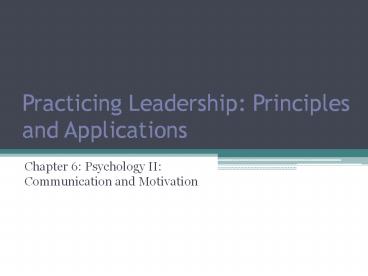Chapter 6: Psychology II: Communication and Motivation - PowerPoint PPT Presentation
1 / 16
Title:
Chapter 6: Psychology II: Communication and Motivation
Description:
Reinforcement Theory. Reinforcement theory: A motivation model that argues that behavior can be shaped by controlling the consequences of that behavior. – PowerPoint PPT presentation
Number of Views:118
Avg rating:3.0/5.0
Title: Chapter 6: Psychology II: Communication and Motivation
1
Practicing Leadership Principles and Applications
- Chapter 6 Psychology II Communication and
Motivation
2
- The single biggest problem in communication is
the illusion it has taken place. - George Bernard Shaw
3
Maslows Hierarchy of Needs
4
ERG Theory
5
Reinforcement Theory
- Reinforcement theory A motivation model that
argues that behavior can be shaped by controlling
the consequences of that behavior. - Three Types
- Classical Conditioning
- Operant Conditioning
- Social Learning Theory
6
Herzbergs Dual Factor Theory
Hygiene Factors Motivational Factors
Absence of Job security Quality of supervision Quality of interpersonal relationships Good working conditions Adequacy of pay and fringe benefits Opportunity for Achievement Advancement Responsibility Job challenge Recognition
7
McGregors Theory X and Theory Y
Theory X Leaders and Managers believe Theory Y Leaders and Managers believe
People inherently dislike work and will try to avoid it. People can view work as an activity as natural as rest or play.
People must be coerced, controlled, or threatened with punishment to achieve goals. People will exercise self-direction and self-control if they are committed to the objectives of the task.
People will avoid responsibilities and seek formal direction whenever possible. The average person can learn to accept and even seek responsibility.
Most people place security above all other factors associated with work and will display little ambition. The ability to make innovative decisions is widely dispersed throughout the general population and is not necessarily the sole province of those in management positions.
8
McClellans Trichotomy of Needs
- Power Motivation
- Drive and Achievement Motivation
- Need for Affiliation
- Every leader is on a continuum for each
need - Low High
9
Equity Theory
10
Expectancy Theory
11
Communication
- Transactional Communication the idea that all
communication involves a sender and a receiver.
Both the sender and the receiver determine the
meaning of the communication that has taken
place. - Channel
- Encoding and Decoding
- Filters
- Sets
- Interference
12
Types of Communications
- Verbal versus nonverbal communication
- Intentional versus unintentional communication
- Formal versus informal communication
- Upward versus downward versus lateral
communication
13
Interpersonal Communication Process
14
Directions of Communications
15
Factors Leading to Breakdowns in Communication
- Differing frames of reference
- Selective perception
- Semantic problems
- Filtering
- Constraints on time
- Communication overload
- Cultural differences
16
Improving Communication
- Using descriptive, as opposed to evaluative,
speech - Taking a collaborative approach to
problem-solving - Communicating with spontaneity, rather than from
hidden strategies or agenda - Demonstrating empathy
- Promoting equality across and within levels of an
organization - Trying to hear all sides of a debate rather than
simply sticking to ones own agenda































